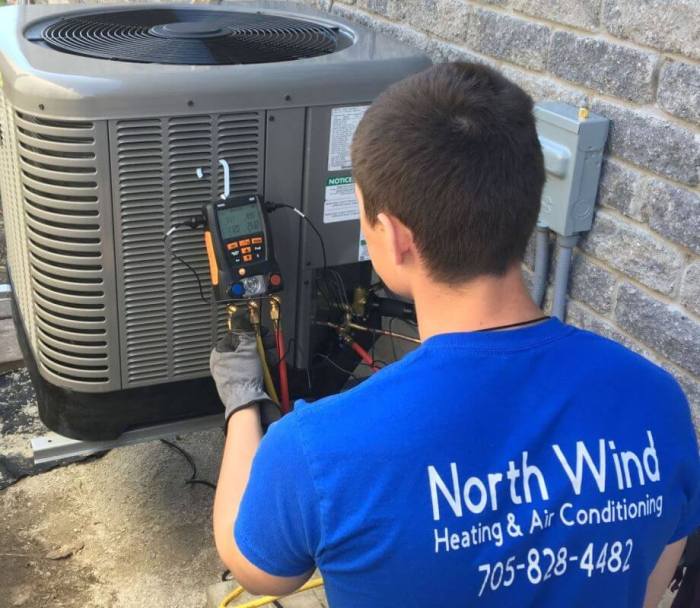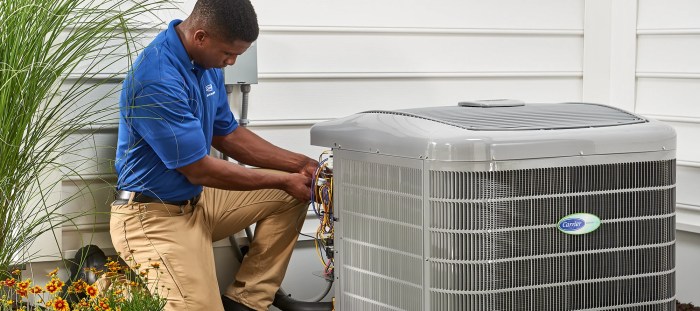Optimizing Carrier HVAC Performance with Regular Maintenance
Carrier HVAC maintenance is integral to ensuring the longevity and efficiency of your system. By delving into the intricacies of maintenance practices, we uncover the key to a well-functioning Carrier HVAC system.
As we explore the components, maintenance schedules, DIY tips, and signs indicating maintenance needs, readers will gain a comprehensive understanding of how to care for their Carrier HVAC units.
Importance of Regular HVAC Maintenance
Regular maintenance is crucial for Carrier HVAC systems to ensure optimal performance, energy efficiency, and longevity. By staying on top of maintenance schedules, homeowners and businesses can avoid costly repairs, extend the lifespan of their units, and maintain a comfortable indoor environment.
Benefits of Consistent Maintenance on Carrier HVAC Units
- Improved Energy Efficiency: Regular maintenance helps keep the system running smoothly, reducing energy consumption and lowering utility bills.
- Enhanced Indoor Air Quality: Cleaning or replacing filters and components regularly can prevent the buildup of dust, allergens, and pollutants, promoting healthier indoor air.
- Prevent Costly Repairs: Routine maintenance can identify minor issues before they escalate into major problems, saving money on expensive repairs down the line.
- Extended Lifespan: Proper maintenance can prolong the life of Carrier HVAC units, maximizing the return on investment and delaying the need for replacement.
Potential Issues from Neglecting Maintenance
- Reduced Efficiency: Dust and debris buildup can hinder airflow, forcing the system to work harder and consume more energy.
- Poor Indoor Air Quality: Neglected filters can lead to the circulation of dirty air, exacerbating allergies and respiratory issues.
- System Breakdowns: Lack of maintenance can result in unexpected breakdowns, leading to discomfort and inconvenience for occupants.
- Shortened Lifespan: Neglected systems are more prone to premature failure, requiring premature replacement and incurring additional costs.
Components of Carrier HVAC System

When it comes to maintaining your Carrier HVAC system, it is crucial to understand the key components that play a significant role in its operation. Regular maintenance of these components ensures the efficient functioning of your system and helps prolong its lifespan.
Air Filters
Air filters are essential components of a Carrier HVAC system as they help trap dust, dirt, and other particles from entering the system. Regularly changing or cleaning the air filters ensures proper airflow and improves indoor air quality.
Thermostat
The thermostat is responsible for regulating the temperature in your home by communicating with the HVAC system. Proper calibration and regular maintenance of the thermostat ensure accurate temperature control and energy efficiency.
Condenser Coils
The condenser coils in your Carrier HVAC system help release heat from your home to the outside environment. Keeping the coils clean and free from debris ensures optimal heat transfer efficiency and prevents your system from overworking.
Blower Motor
The blower motor in the HVAC system is responsible for circulating air throughout your home. Regular maintenance, including lubrication and cleaning, can help prevent motor failure and ensure proper airflow.
Refrigerant Levels
Proper refrigerant levels are crucial for the efficient operation of your Carrier HVAC system. Low refrigerant levels can lead to decreased cooling capacity and higher energy consumption. Regular maintenance checks can help identify and address any issues with refrigerant levels.
Maintenance Schedule for Carrier HVAC
Regular maintenance is crucial to ensure the optimal performance and longevity of your Carrier HVAC system. By following a maintenance schedule, you can prevent unexpected breakdowns and costly repairs. Here is a recommended maintenance schedule for your Carrier HVAC system:
Monthly Tasks
- Check and replace air filters if necessary.
- Inspect thermostat settings and recalibrate if needed.
- Clear any debris or obstructions around the outdoor unit.
Quarterly Tasks
- Inspect and clean evaporator and condenser coils.
- Check refrigerant levels and top up if necessary.
- Inspect ductwork for leaks or damage.
Bi-Annual Tasks
- Inspect and lubricate moving parts, such as fan motors and belts.
- Test and calibrate the thermostat for accuracy.
- Check electrical connections and tighten if needed.
Annual Professional Maintenance Visit
It is recommended to schedule a professional maintenance visit at least once a year. During this visit, a certified technician will perform a thorough inspection of your Carrier HVAC system, identify any potential issues, and make necessary adjustments to ensure optimal performance.
DIY Maintenance Tips for Carrier HVAC

Performing regular maintenance on your Carrier HVAC system can help ensure optimal performance and extend its lifespan. Here are some DIY maintenance tips for homeowners to keep their Carrier HVAC units running smoothly.
Cleaning or Replacing Filters
Regularly cleaning or replacing filters is crucial for the efficiency of your Carrier HVAC system. Follow these step-by-step instructions to clean or replace filters:
- Turn off the HVAC system: Before starting any maintenance, make sure to turn off the power to the system to prevent any accidents.
- Locate the filters: Filters are typically located in the return air duct or near the air handler. Remove the access panel to reach the filters.
- Inspect the filters: Check the condition of the filters. If they are dirty or clogged, it’s time to clean or replace them.
- Cleaning the filters: If the filters are reusable, vacuum them or wash them with mild soap and water. Make sure they are completely dry before reinstalling.
- Replacing the filters: If the filters are disposable, make sure to replace them with the correct size and type recommended by Carrier.
- Reinstall the filters: Once cleaned or replaced, carefully reinstall the filters and secure the access panel.
- Turn on the HVAC system: After completing the filter maintenance, turn the power back on and monitor the system for any changes in performance.
Remember to check and clean or replace your filters every 1-3 months, depending on usage, to ensure optimal airflow and efficiency.
Safety Precautions
When performing DIY maintenance on your Carrier HVAC system, it’s important to consider the following safety precautions:
- Wear protective gear: Use gloves and eye protection to prevent any injuries while handling components.
- Turn off power: Always turn off the power to the system before performing any maintenance to avoid electrical shocks.
- Follow manufacturer instructions: Refer to the user manual for specific maintenance guidelines provided by Carrier.
- Avoid overexertion: If a task seems too complex or risky, it’s best to contact a professional HVAC technician for assistance.
- Keep the area clear: Ensure there are no obstructions around the HVAC system to allow for easy access and ventilation.
Remember, regular DIY maintenance can help improve the efficiency and longevity of your Carrier HVAC system. By following these simple tips, you can ensure your system operates smoothly and effectively throughout the year.
Signs That Carrier HVAC Maintenance is Needed
Regular maintenance is crucial to keep your Carrier HVAC system running smoothly and efficiently. By paying attention to certain signs, you can determine when it’s time to schedule maintenance for your unit.
Unusual Noises
One of the most common signs that your Carrier HVAC system needs maintenance is the presence of unusual noises. Clanking, banging, or squealing sounds coming from your system could indicate loose or worn-out parts that need attention from a professional technician.
Strange Smells
If you notice strange odors coming from your vents when your HVAC system is running, it could be a sign that the system needs maintenance. Musty or burning smells can indicate mold growth, electrical issues, or other problems that require professional intervention.
Poor Performance
Decreased airflow, inconsistent temperatures, or frequent cycling on and off are all signs of poor performance in your Carrier HVAC system. These issues can be caused by dirty filters, clogged ducts, or malfunctioning components that need to be addressed through maintenance.
When to Seek Professional Maintenance
While some minor maintenance tasks can be performed by homeowners, it’s essential to seek professional maintenance services for more complex issues with your Carrier HVAC system. If you notice any of the aforementioned signs or if your system is not heating or cooling effectively, it’s time to call a certified technician to inspect and repair your unit.
Conclusive Thoughts

In conclusion, maintaining your Carrier HVAC system is not just a task but a crucial investment in its performance and longevity. By following the guidelines Artikeld here, you can enjoy a comfortable and efficient indoor environment for years to come.
Common Queries
How often should I schedule maintenance for my Carrier HVAC system?
It is recommended to have professional maintenance visits at least once a year to keep your Carrier HVAC system running smoothly.
What are some DIY maintenance tasks I can perform on my Carrier HVAC unit?
You can start by regularly cleaning or replacing filters, ensuring proper airflow and efficiency in your system.
What are some signs that indicate my Carrier HVAC system needs maintenance?
Unusual noises, strange smells, or reduced performance are all indicators that your Carrier HVAC system requires maintenance attention.




